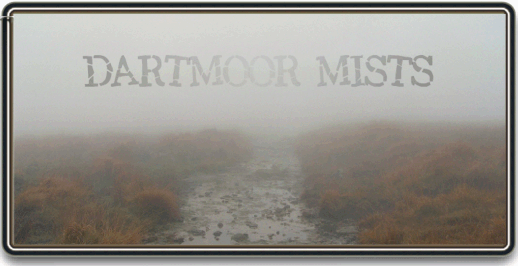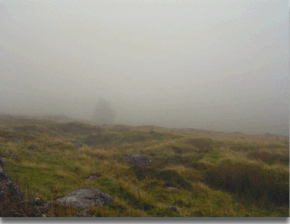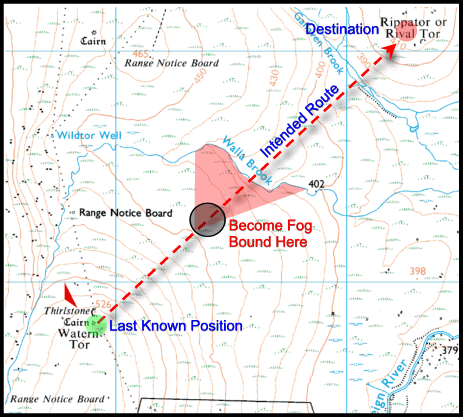
“Dartmoor is very high, and a cloud need stoop very little
to clasp the Moor to its clammy bosom.”
Probably the most feared aspect of Dartmoor is the dreaded mists, they can appear without warning and blanket the moor in an impenetrable and visionless cloak, catching the unwary and occasionally leading them into a bottomless mire. What started out in a stroll bathed in brilliant sunshine can end up in a navigational nightmare just in order to get safely back to civilisation. Basically a mist is a blanket of low cloud which considering the height and location of Dartmoor means they can be a common occurrence. The south-western peninsula is subjected to an air-flow that predominantly comes from the west or south-west. This airflow is laden with moisture that it has picked up from the warmer currents of the mid-Atlantic Drift which it then carries westwards. After heading over Bodmin Moor the next obstacle the air currents meet is the high granite plateau of Dartmoor. The higher altitudes and lower temperatures of the moor mean that it tends to have a more extreme climate than the rest of Devon. This is due to the fact that as the south-westerly air currents are taken up over the moor they are cooled by by the lower temperatures and thus creates cloudy conditions. These either manifest themselves in precipitation or mists both of which are not particularly good for trundling around the moor.
There is one other way that mists can form on Dartmoor, many moor folk will tell you that the piskies have the ability to summon thick mists in order to confuse any unwary travellers. Once the mist has been conjured up the hapless person wanders around aimlessly until the spell wears off, then they are said to have been – ‘piskie lead‘. But don’t worry because as long as you don’t ‘hack’ the little folk off you will be alright, if you do then best take a flask of coffee because you’ll be wandering around for quite some time!
When the prevailing conditions are right the mists can lay over Dartmoor for several days which is bad news if you are stuck in some remote spot.
J, Ll. W. Page describes his winter-time adventures in a Dartmoor mist:
“I remember ascending Yes Tor one winter’s morning when the fog had been laying on the surface of the waste for nearly a week… I knew the mountain well, and my companion – in his own opinion – knew it still better. Having, after some difficulty, attained the summit it was proposed to descend, and we started, I against my better reason, consenting to follow in his footsteps. Somehow the rocks did not seem as familiar as of yore, and many times I suggested we were leaning too much to the left. However, as we could only see twenty yards or thereabouts, my remarks met with no corroboration, and onwards we stumbled. Suddenly a scarcely perceptible draught coming up the valley caused the fog to disperse a little and two rocky peaks started suddenly into being. They represented part of the summit of Blackator – we had descended the wrong side.”
I doubt that there is not a single person who regularly treads the high moors either for pleasure or work that has not become lost in a mist. In my opinion there can be no person who had a greater knowledge of the whole of Dartmoor than William Crossing. His theory was that in addition to a map and compass:
“… one who knows the moor as thoroughly as to be able to ascertain his whereabouts in a mist by noticing the nature of the ground around him, that which might prove an impediment and a stumbling-block to a stranger, is as a beacon of light, serving him to know his exact position, and though the way may yet be not easy, (so thick are these mists that everything around is concealed from view) still he can be in no danger of losing himself entirely.“
Despite that worldly advice it is so easy to get lost, only this year I spent several hours trying to find Shapley Tor in a thick mist and even then I couldn’t locate it.
But what can be done if suddenly confronted with a mist when you are far into the moor or simply just on the moor come to that? Probably in the age of the GPS things are a lot easier and so if you have such a beast it is always handy to mark your starting point. That way if a mist does descend you simply let the thing lead you back from whence you came. Failing that it is imperative to have a map and compass and more importantly know how to read one and use the other. But even then in a really thick mist it is hard to navigate if you can’t see and landmarks. Some say that prevention is better than cure and its best not to place oneself in a situation of being fogbound. Another regular walker of the moor was Eric Hemery and he has the following advice to impart:
“A dartmoor mist can lead an unprepared walker into difficulties by enveloping him. The warning signs – a combination of leaden sky, damp atmosphere and haze increasing on the hilltops – are usually lost on the stranger.“
So in other words always keep a weather-eye open for any tell-tale signs that conditions may be changing for the worse. More importantly consult as many local forecasts as possible before setting out – that will save a lot of time and anxiety. But to play Devil’s advocate, suppose everything seemed ok when you started out and your route had been logged into the GPS. No sooner had you reached the remotest spot of the walk than the mist suddenly descends. No problem get out the GPS and let it do the hard work but then you realise that somehow you’ve dropped it or perhaps the batteries have gone flat and there are no replacements – then what. You have not been following a map so you have no idea where you are apart from the recollection of a coffee-stop at the last tor around an hour ago – now what? Phone for help? Sorry there is no phone signal and believe me there are surprisingly enough many places on the high moor were there is no signal. You look around and can see nothing apart from the odd rock or two, now the panic begins to set in. Whilst trying to get a feint idea of where you are you have wandered around and now you are unsure from which direction you came – oh bugger!

The main thing to do is not to panic, get your flask of coffee out and calm down, don’t be afeared of the huge figure that is menacingly looming out of the mist, it’s only a sheep. This is another phenomenon of the mist, everything takes gigantic proportions and what seems like a pony is a sheep and that elephant is only a pony. Having taken stock of the situation, if you are certain you have no idea as to your whereabouts sit still and listen. The other feature of a mist is that sound carries a very long way. I remember a few years ago sat talking to a friend about a certain lady walker of the moor, we were sat having coffee in a thick mist. A few days later I met said lady and received a severe mauling because of what I had said. It transpired that she too was on the moor and heard everything we said.

Imagine that you were walking from Watern tor to Rival tor when the mist came down exactly where the grey circle is. You sit down and have a recap on the journey so far; you know for certain that a 13.00 you stopped at Watern Tor. It is now 13.10 which means at an average walking speed of 50m per minute you have travelled 500m. The map will show that roughly 500m from Watern tor will take you to the apex of the red zone. If you then look at the map you can see the Wallabrook, you know for a fact that you haven’t crossed any water since leaving Watern tor therefore you have gone no further than the top edge of the red zone. You also know that since 13.00 you have been gently walking downhill, once again this places you somewhere in the red zone. It is now possible to estimate your position within a fairly small area, ie the red zone. In this situation the safest way off the moor would be to head due south until you meet the wall at the bottom of the map. This would then allow precise navigation by means of following the wall along with the map until it safely brought you to the unseen Fernworthy Reservoir. Failing this, as Crossing says:
“The plan of following a stream is the very best that anyone who has any doubt about his way, when lost in a mist, can adopt; and though, perhaps, conducting him far from his desired destination, will yet enable him to reach the roads on the confines of the moor.“
Which basically means that if you pick up one of the hundreds of streams, brooks or rivers it will eventually lead you off the moor, a leat is always another good alternative. So, strain your ears for any sound of civilisation and at the very worst the sound of running water.
There is another feature associated with mists and I have only ever seen it once, It was early one autumn morning and I was walking along a high ridge, down below the valley was filled with mist. As the sun came up the mist rose up like a wall from the valley until the top of it was about 10ft above the horizon. Suddenly a ghost-like figure appeared before me which was a trifle disturbing to say the least, Then I realised what it was, the sun which was behind me was projecting my shadow onto the dense wall of mist which was acting as a screen. This is known as a ‘brocken’, mostly because the phenomenon was first observed on Brocken, Harz Mountains, Northern Central Germany.
In particularly cold spells the mist can magically produce what is known as an ‘ammil‘ which is when everything is coated in ice because the temperature has suddenly dropped and frozen a layer of moisture over all and sundry.
 Legendary Dartmoor The many aspects past and present of Dartmoor
Legendary Dartmoor The many aspects past and present of Dartmoor
